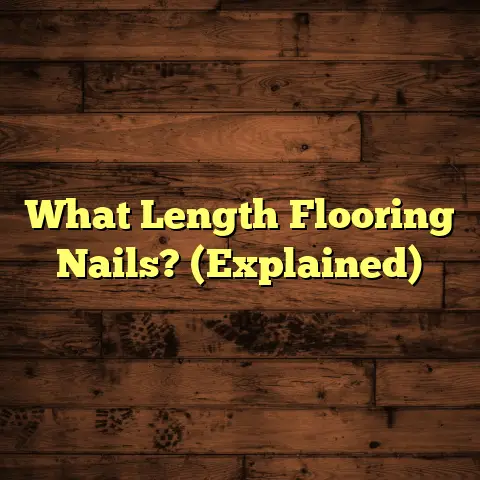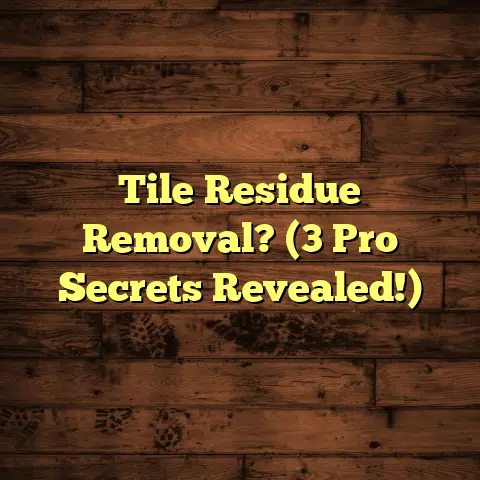Screws in Concrete Slabs? (3 Tricks You NEED!)
Introduction: The Timelessness of Concrete and the Quest for Stability
Concrete, right? It’s been around forever.
From Roman aqueducts to today’s skyscrapers, it’s the go-to for strength and durability.
But let’s be real, modern construction throws some curveballs. We need to fasten things securely in concrete slabs, and that’s where things get interesting.
Screws might seem like a “wood thing,” but trust me, with the right tricks, they’re a game-changer for concrete too.
I’m going to walk you through three essential techniques that’ll make sure your screws hold tight and last. Let’s dive in!
Section 1: Understanding Concrete Slabs and Their Properties
1.1 The Composition of Concrete
Okay, so what’s concrete actually made of?
It’s a mix of cement, sand, gravel, and water. Cement acts like the glue, binding everything together.
The ratio of these components is crucial. Too much water, and you weaken the concrete. Too little, and it’s unworkable.
Curing is also key. It’s the process where concrete hardens over time.
Proper curing is essential for achieving maximum strength. This can take days or even weeks.
1.2 The Structural Role of Concrete Slabs
Concrete slabs are workhorses. Foundations, floors, you name it.
They’re designed to handle massive loads. The thickness of the slab, the type of reinforcement (like rebar), and the concrete mix all play a role in its strength.
Did you know that a typical residential concrete slab is usually around 4 inches thick? It’s designed to handle the weight of furniture, appliances, and people.
1.3 Challenges of Fastening in Concrete
Now, let’s talk about the challenges.
Concrete is HARD. Trying to force a screw directly into it is a recipe for disaster.
You risk cracking the concrete, stripping the screw, or just plain failing to get a good hold.
You need the right tools and techniques to overcome these challenges.
Section 2: The Right Screws for Concrete Applications
2.1 Types of Screws Suitable for Concrete
Not all screws are created equal.
For concrete, you need specialized screws or anchors. Here are a few options:
-
Masonry Screws: These are designed to tap directly into concrete.
-
Tapcon Screws: A popular choice, they require a pre-drilled hole and offer good holding power.
-
Expansion Anchors: These use a sleeve that expands when the screw is tightened, creating a very strong hold.
Each type has its pros and cons. Tapcons are generally easier to install, while expansion anchors offer more strength.
2.2 Choosing the Correct Size and Length
Size matters! You need to choose a screw that’s appropriate for the thickness of the concrete and the weight of what you’re securing.
As a rule of thumb, I like to make sure the screw penetrates at least 1 inch into the concrete.
If you’re hanging something heavy, go for a longer, thicker screw. It’s better to be safe than sorry.
2.3 Material Considerations
Corrosion is the enemy. If you’re working in a damp environment, you need to use corrosion-resistant screws.
Stainless steel is a great option, but it can be more expensive.
Galvanized screws are a more affordable alternative.
Remember, rust can weaken the screw and eventually lead to failure.
Section 3: Trick #1 – Pre-drilling for Precision
3.1 The Importance of Pre-drilling
Okay, this is huge: Always pre-drill!
Trying to drive a screw directly into concrete is a bad idea.
You’ll likely crack the concrete or strip the screw head.
Pre-drilling creates a pilot hole that guides the screw and reduces stress on the concrete.
3.2 Selecting the Right Drill Bit
You need a special drill bit for concrete.
Carbide-tipped or masonry bits are the way to go.
These bits are designed to withstand the abrasive nature of concrete.
The diameter of the drill bit should match the screw size. Check the screw manufacturer’s recommendations for the correct drill bit size.
3.3 Techniques for Effective Pre-drilling
Here’s how I pre-drill like a pro:
-
Mark the spot: Use a pencil to mark where you want to drill.
-
Start slow: Begin drilling at a slow speed to prevent the bit from wandering.
-
Apply steady pressure: Don’t force the bit. Let it do the work.
-
Drill to the correct depth: Use a depth gauge or mark the bit with tape to ensure you drill to the proper depth.
-
Clean the hole: Use a brush or compressed air to remove dust and debris from the hole.
Section 4: Trick #2 – Using the Right Tools for Installation
4.1 Essential Tools for Fastening in Concrete
You’ll need a few key tools:
-
Power Drill: A standard power drill can work for smaller screws, but an impact driver is better for larger screws.
-
Impact Driver: An impact driver delivers rotational bursts of power, making it easier to drive screws into hard materials like concrete.
-
Hammer Drill: If you are using larger diameter anchors, a hammer drill will make the pre-drilling process much easier and faster by using a hammering action along with the rotation.
-
Drill Bits: As we discussed, you need carbide-tipped or masonry bits.
-
Safety Glasses: Protect your eyes from flying debris.
-
Dust Mask: Concrete dust can be harmful to your lungs.
4.2 Techniques for Optimal Screw Installation
Here are some tips for installing screws:
-
Start slow: Begin driving the screw at a slow speed.
-
Apply steady pressure: Don’t force the screw. Let the tool do the work.
-
Avoid stripping the screw head: If the screw starts to strip, stop immediately and try a different screw or a larger drill bit.
-
Don’t overtighten: Overtightening can damage the concrete or strip the screw.
4.3 Safety Precautions
Safety first! Here are some things to keep in mind:
-
Wear safety glasses: Protect your eyes from flying debris.
-
Wear a dust mask: Concrete dust can be harmful to your lungs.
-
Use hearing protection: Power tools can be loud.
-
Be aware of your surroundings: Make sure there are no electrical wires or pipes in the area where you’re drilling.
Section 5: Trick #3 – Utilizing Adhesives for Added Strength
5.1 The Role of Adhesives in Concrete Fastening
Want to take your fastening game to the next level?
Use construction adhesive!
Adhesive adds an extra layer of security, especially when you’re hanging something heavy or working in a high-vibration environment.
5.2 Types of Adhesives for Concrete Applications
There are several types of adhesives that work well with concrete:
-
Epoxy: Epoxy is a two-part adhesive that creates a very strong bond. It’s ideal for heavy-duty applications.
-
Polyurethane: Polyurethane is a flexible adhesive that’s good for filling gaps and sealing joints.
-
Construction Adhesive: This is a general-purpose adhesive that’s suitable for a wide range of applications.
5.3 Application Techniques
Here’s how to apply adhesive:
-
Clean the surface: Make sure the concrete is clean and free of debris.
-
Apply the adhesive: Apply a bead of adhesive around the pre-drilled hole.
-
Insert the screw: Insert the screw and tighten it until it’s snug.
-
Allow the adhesive to cure: Follow the manufacturer’s instructions for curing time.
Conclusion: Mastering the Art of Fastening in Concrete
So there you have it: three essential tricks for using screws in concrete slabs.
Remember: pre-drilling, using the right tools, and utilizing adhesives can make all the difference.
With the right knowledge and equipment, you can master the art of securing screws in concrete and ensure that your projects are durable and long-lasting.
Now go out there and build something amazing!
By following the guidance outlined in this article, readers will be well-equipped to tackle their fastening needs in concrete slabs, paving the way for successful construction and renovation projects that stand the test of time..





